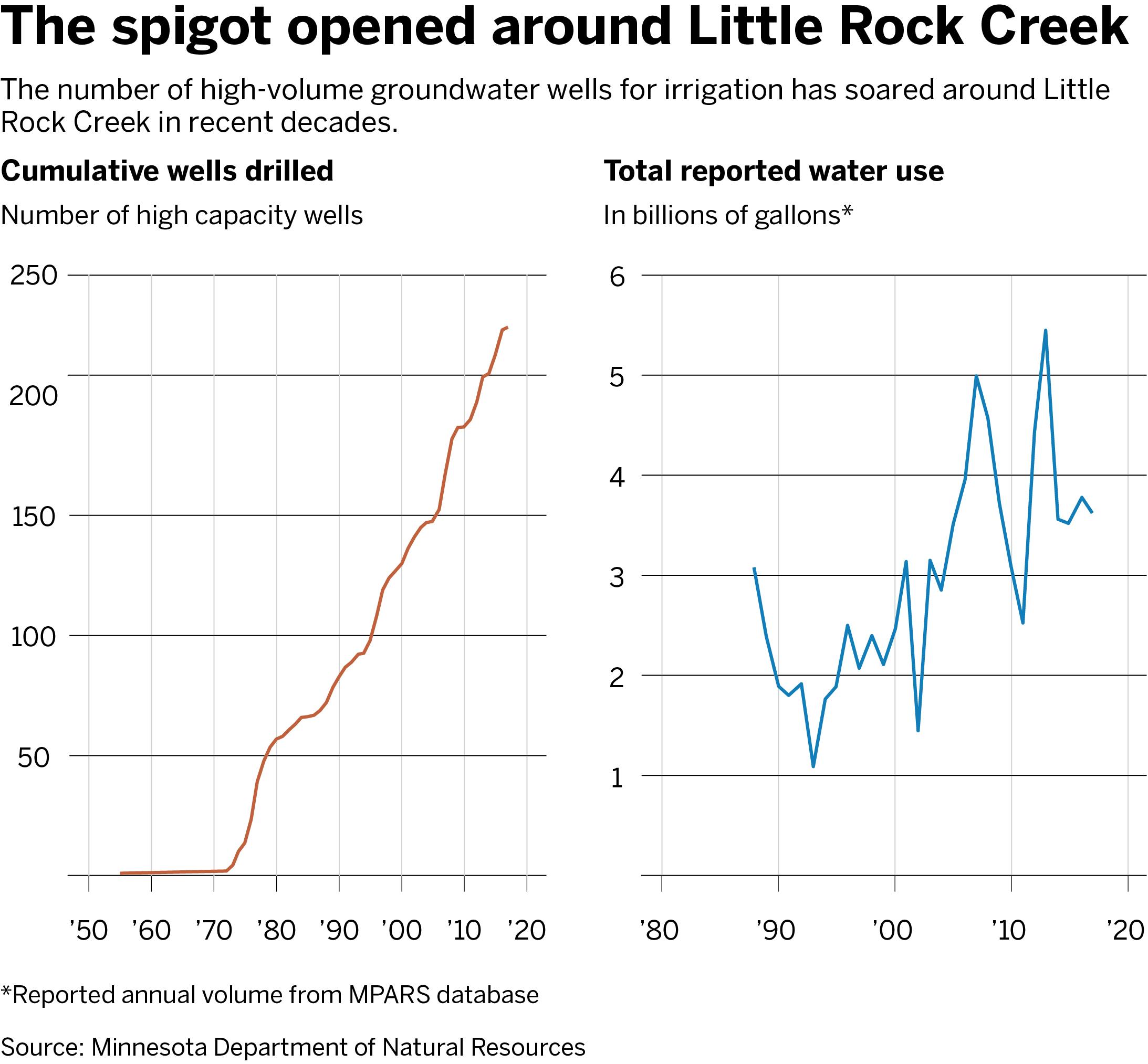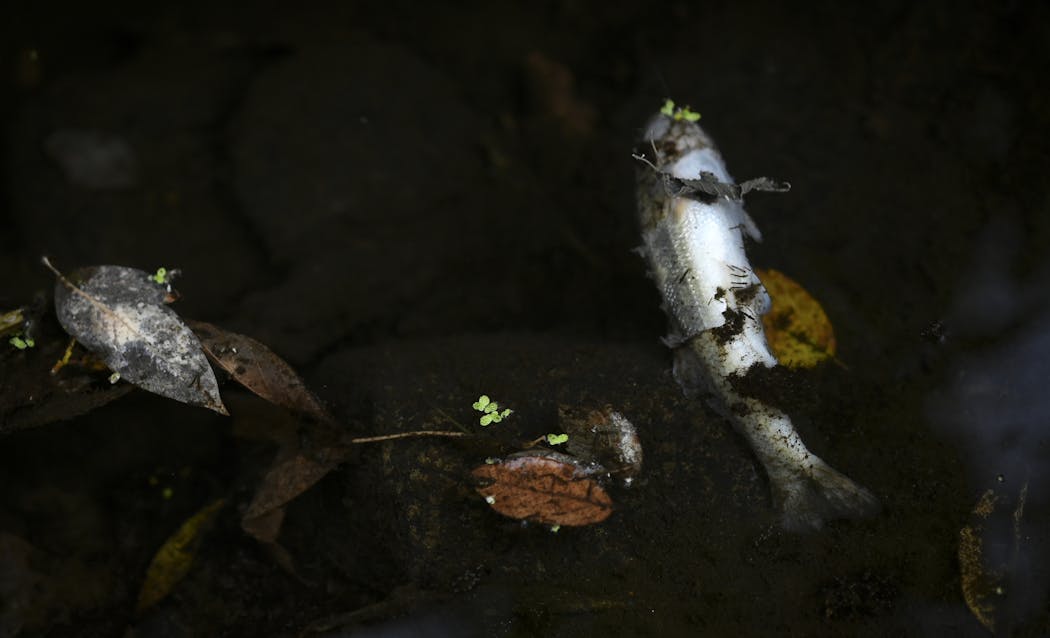RICE, Minn. – Ken Nodo has spent his entire life on Little Rock Creek. Every Sunday after church as a boy, he said, he'd grab his fishing pole and bring home supper.
That's a dream now. There's just not much to catch anymore. It's disheartening, said Nodo, 81: "There's less fish, less water."
A key culprit in the trout stream's demise, state regulators have found, lies in the booming central Minnesota cropland Little Rock Creek winds through. Every year, farmers pump billions of gallons of groundwater to quench thousands of acres of potatoes, corn, soybeans, alfalfa, kidney beans and other crops. Irrigation has transformed Morrison and Benton counties' famously sandy soil into lush and thriving farm country.
But it's sucking the life from the creek. The pumping lowers Little Rock Creek flows by up to one-quarter some summers, the state has found, destroying fish habitat in a devastating pattern only exacerbated by this year's severe drought.
Regulators have known there was a problem since at least 2010 but have yet to land on a solution. Meanwhile, the state-designated trout stream continues to languish and frustrated growers look on, worried their water supplies could be cut.
Similar conflicts are playing out across Minnesota as the state struggles to balance ever-growing demands on groundwater with the needs of its rivers and streams. Little Rock Creek is not the biggest body of water to be threatened, but what happens here could shape Minnesota's solutions.
The state Department of Natural Resources (DNR), which issued the irrigation permits lowering the creek, cannot document exactly how much groundwater it has allowed to be pumped from aquifers. The agency continued to issue permits even as it recognized creek levels were sinking, and it still hasn't decided whether to restrict irrigation.
Jason Moeckel, a DNR official helping lead the Little Rock Creek project, said the stream's low flow is intermittent and seasonal — and not an emergency.
"It's not like people are running out of water in their wells. That would be an emergency," Moeckel said. "There is some urgency. There's a difference."
The aquifer system appears to be fluctuating within normal range, but the times of heaviest pumping still drain water from the creek.
Anxious farmers want solutions, not more meetings. The DNR says it needs to be able to defend its decisions in court, particularly if it alters irrigation permits. Science takes time, it says.
To Nodo, the fish in Little Rock Creek are the "the canary in the coal mine."
"It tells you that you're doing something not good to the environment if you can't support the trout," he said.
A stream through farmland
On maps, Little Rock Creek looks like an unfinished "C" drawn by a toddler. It meanders some 30 miles through bountiful farm country dotted with large homes, two-story Gold'n Plump chicken barns and an army of irrigation equipment.
It was a very different place in the 1960s and 1970s, before irrigation arrived. There were dairy farms and farmers grew rye, oats and corn, locals recalled. But the soil was so dry and sandy that farmers struggled to make a living, said longtime farmer Diane Wojtanowicz.
"They were just at the mercy of what was going to happen," she said.
Wojtanowicz's late husband, John, is credited with installing the area's first irrigation system in 1969. The deep well delivered a rush of groundwater that doubled their corn yield.
It added certainty — and others followed. There are now nearly 240 high-capacity wells in the area, one of the higher concentrations in the state, pumping somewhere around 4 billion gallons of groundwater a year.
It's an estimate. Irrigation systems aren't metered the way municipal water users are. State law requires irrigators to measure their water "within an accuracy of 10%" and report it annually to the DNR, but it's largely an honor system. There are no compliance checks.
Meanwhile, the stress of agriculture on the creek is evident.
In 2002, the Minnesota Pollution Control Agency (MPCA) listed Little Rock Creek as "impaired" for being too polluted to support cold-water-loving trout. Two more stretches of creek were added to the list in 2010 for lacking enough oxygen for fish and insects, and having excess nitrate from farm chemicals. More impairments, including too much bacteria, were added in 2020.
The creek's pollution finds its way to Little Rock Lake, where it empties before running to the Mississippi River, said Miranda Nichols, the MPCA's impaired-waters list coordinator. The lake's water quality "by any way you look at, is among the poorest in the state," she said.
Water quality is not the only problem.
As early as 2008, the state suspected the groundwater pumping was depleting the stream in the summer, said MPCA hydrologist Andrew Streitz. Facing a surge of irrigation applications near the creek in 2014, the DNR took a closer look.
The stream's water drops by up to a quarter in August during the worst years, the agency found. When that happens, a third of habitat for brown trout juveniles is lost along with a third of the habitat for adult johnny darters, an important forage fish for larger species. They are indicators, and any fish and insects using similar habitats will suffer. Adding to the puzzle: The drops in the creek's flows have occurred during the state's wettest decades, as climate change increases precipitation.


Making matters worse is the small dam on the creek in the Sartell Wildlife Management Area, about 3 miles north of Little Rock Lake. The DNR itself had it installed around 1978 for duck habitat, a practice now out of favor, the agency said. All the pooled water behind the dam has raised the creek's temperature — dangerous for cold-water fish such as trout.
The DNR continues stocking Little Rock Creek, pouring about 10,000 brown trout fingerlings annually along a 5-mile stretch. Some survive to adulthood, but almost none have reproduced, said Eric Altena, DNR area fisheries manager in Little Falls.
'Virtually worthless'
Growers are bewildered — and angry — that so much effort has been spent keeping a fish alive in a subpar stream that one called "nothing but a crick."
Marlene Schlichting, whose family has irrigated near the creek for decades, said the DNR has stocked the creek with trout since the early 1900s "and it never worked."
"When do you start to wonder if it's like we're trying to have a giraffe live in a climate where a giraffe can't live?" she asked.
The Schlichtings grow kidney beans, corn, potatoes, alfalfa and other crops. Without irrigation the land is "virtually worthless," Schlichting said.
"One out of every four years you might get a crop," she said.
Others said the shallow creek has always dried up on occasion. Steven Traut, president-elect of the Minnesota Water Well Association, said he shot carp in the creek in high school in the mid-1970s. The water was ankle deep then, he said. As he sees it, the situation is "way out of perspective."
"If you lose $30,000 of fish in the creek vs. hundreds of millions of dollars in crops because you don't let guys irrigate … somewhere we have to be economical," Traut said.
The DNR also recently discovered that some irrigators are actually pumping less water than they report, and that many may not be measuring within the 10% accuracy required by state law.
Most farmers don't use flow meters, which many irrigation experts say are the most precise way to measure water use. State law only requires flow meters on wells pumping more than 1,500 gallons per minute — far higher than those used for farming.
Most farmers rely on a general pump rate, often set when the well is drilled, and multiply it by the hour gauges on the irrigation equipment.
To study the difference in measurements, eight farmers near Little Rock Creek volunteered to install ultrasonic flow meters on their irrigation systems in 2018 and 2019. Most of the farmers overreported their annual water use, although two pumped more than reported one year.
The DNR said it suspects farmers aren't pumping as much as they think because wells and irrigation equipment get old and less effective.
Moeckel acknowledged the reporting could be better but said it's good enough for the DNR to sustainably manage the state's groundwater.
"The question is, is it accurate enough to meet the needs of the statutes? I would say the answer on that is on balance, yes," he said.
Frustrating search for a fix
In a clear concession to growers, the DNR now says the goal is not to halt Little Rock Creek's streamflow depletion, but lessen it. It has laid out a host of options to cut the drop in the August flow from 25 to 15%.
"This is the first place in Minnesota where we're doing this," Moeckel said. "We're just learning our way through this, frankly."
Options include altering the dam, moving some irrigation wells away from the creek, or finding ways to store water on the land, such as in wetlands, to create more opportunities for it to seep back down. Another option, favored by growers, is pumping groundwater into the stream when it gets low. That's the approach taken in northwest Washington when irrigation started depleting a creek there.
The option the DNR said it wants to avoid: modifying irrigation permits to conserve water.
The agency hasn't rejected any irrigation permit applications, despite awareness of the area's problems. Instead, it stuck a "limited" designation on more than two dozen permits issued since 2017. It's just a warning, Moeckel said, that the permit might not be renewed.
That alarmed farmers, who want the uncertainty about their ability to draw groundwater to end.
"Without water, my nursery cannot operate," said Randy Klaphake, who runs a wholesale tree nursery near Royalton. "They keep dragging their feet and say they're looking at this, looking at that. It's frustrating."
Nodo, who runs a vineyard, said he understands farmers need a reliable supply of water. But the stream belongs to everyone, he said, and should be healthy enough to support the fish whether they're introduced or not.
Gerry Maciej, a Benton County Soil and Water Conservation District manager, is optimistic about striking a final compromise. Irrigation practices have improved and gotten more precise, he said, ensuring less water goes to waste.
"I've been watching this evolve and develop for years and I still believe we can irrigate, if we do it responsibly and still have healthy natural resources," Maciej said.
The DNR will meet again with farmers this winter about the path forward.
"I don't think it's insurmountable and it's not an emergency," said the DNR's Moeckel, "but we do need to fix the problem."
8 months in jail for Blaine man who caused 120-mph crash hours after he was caught speeding

Daughter sues St. Paul, two officers in Yia Xiong's killing


